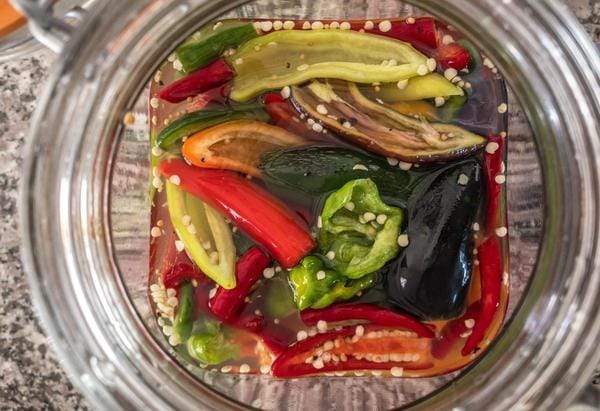This year our Trial Gardens and Germination Manager, Jaci, grew out our Pinetree Hot Pepper Mix to get a new photo of it. After we photographed it, we needed to make use of all the lovely peppers. So, what do you do with a basket full of hot peppers? Well, I make hot sauce because I love hot sauce.
Before my wife and I took over this seed company, I was a chef. So even though I love cooking and making things (#makersgonnamake), recipes are not my favorite. I love techniques and that's what I am giving you here, my fermented hot sauce method and/or technique. It’s not a recipe but it is the basic instructions for creating a fermented hot sauce with room to add your own spin on it.
This is a brine fermentation. You basically create a brine and submerge the hot peppers and wait. I love this method because not only does it produce a pretty awesome hot sauce, you also get a really flavorful spicy brine to use in other dishes. I like my hot sauce to be smooth, spicy, and acidic (like me😏). The base for this hot sauce can be as smooth as you want to make it but it won’t be that acidic, so I add a little splash of vinegar at the end when I puree. You certainly don’t have to do this and probably some would say it defeats the purpose of fermenting the hot sauce. Maybe I am compromising my culinary integrity, but vinegar is amazing and I love the addition!

What you need:
Hot peppers - Use whatever you have and as many as you have!
2% Brine - 20 grams of salt to 1 litre of water (I use Kosher). I weigh everything and you should too. If you don’t have a scale, you can add 1 Tbsp salt to 1 quart of water and get the correct ratio.
Anything else you want to add to the ferment - Collect any flavors you like and add them into the brine. I throw in a bunch of mustard seeds, some garlic cloves, some black peppercorns, and maybe a bay leaf or two. You can wrap your seasonings in cheesecloth to make it easier to remove later.
A jar - This should be a container meant for canning and fermenting (it is best to avoid metal containers as it can be reactive to the acid in the fermentation process). The fermentation process creates gas which creates pressure in the jar. You’ll be relieving that pressure regularly but you need a container that can handle it. Basic Ball jars work great and you can use one size jar to fit the whole batch or spread it out over several jars.
Gloves - Latex, vinyl, neoprene
What to do:
- Make your brine. Measure out the amount of water you’re using and add the appropriate amount of salt and any other spices that you’re using. Some people like to heat this up to dissolve the salt. If you heat it, you have to wait for it to cool before you add it to the peppers. I choose not to heat it and just stir it around for a while to dissolve the salt.
- Put on gloves. Do not skip this step and save yourself some pain. Also, do not touch your eyes or face while handling peppers.
- Chop up your peppers. I give them a really rough chop. Some of them I only cut in half and pull the seeds out. Some of them I cut in half and leave the seeds in. I’m pureeing my sauce to be smooth so I don’t worry about the seeds. If you prefer a sauce that is thick and chunky with no seeds then you’ll need to take the seeds out at this step. You can remove them later but it’s a lot more work.
- Add the peppers to the jar and then cover with the brine. You’ll need to add some sort of weight to keep the peppers submerged in the brine. I usually use an upside down plate. You can purchase fermenting containers that provide a weight in the lid or glass weights designed specifically for Ball jars, but if this is your first try, keep it simple and use what is handy (ceramic or glass is ideal).
- Wait. I let this go for about a month, or at least I try to (I’m pretty impatient and I get excited so it ends of being more like 3 weeks to a month). *Important* during this time, you're going to need to open up the jar every day or 2 to relieve the pressure. I do it each day but only because I like to smell it and look at it.
- Make the sauce. Here’s what I do: Strain the brine out into a separate container because you definitely want to save it. Put the peppers into a food processor or blender. Add a little of the brine and puree to desired consistency. If it looks too thick, SLOWLY add a little more brine and continue to puree till you have the desired consistency.
- Bottle it. Get some retro labels and fancy bottles for it and give it out to all of your friends. You’ll need to make up a cool name for it first. Or just put it in your fridge and eat it because it is delicious.
Important Tips to Remember:
- Do not forget to put your gloves on before you cut the peppers.
- Do not forget to let the pressure out of the jar everyday.
Here are some important details to keep in mind about fermenting:
Food can go bad. Mold can grow. If you see a white film on the top, that’s yeast and doesn’t necessarily mean anything bad. If it looks or smells bad, don’t eat it. Use common sense in what you ingest. Try this process at your own risk.
Don't get discouraged if it doesn't work. Do more research and try again. I’ve had many things fail. It happens. It is disappointing but it happens and it makes you better.
Pinetree Garden Seeds is not responsible for any outcomes, unless they’re good, then we take all of the credit. 😊


I start many different hot peppers in my 8 × 10 ft greenn house, transplant large qtys to the garden but do not pick the peppers from many of the plants. I let them mature and peppers start to dry on the plants then pull the whole plants, hang them in my basement until peppers are completely dryed out then pull the peppers and crush them in a blender and bottle in small shaker jars. This makes an outstanding veRRRy hot pepper seasoning. ( FAR BETTER THAN ANY STORE PURCHASED) I will now also try your brining process, thank you
I fermented green jalapenos last year and the sauce is great – similar to Sirachi sauce which is fermented red jalapenos. I bought the Pinetree hot pepper mix and after 10 days I have 33 of 42 seeds up! Very excited to grow these and discover what I got along the way. Starting ten 5 gallon pots early and trying several ways of keeping the grounded peppers warm at night – our 6a mountain air can slow them down in the Spring. I will be fermenting peppers and some pickles much of the growing season. To “burp” the fermentation without opening the jar every day (or worse forgetting to) you can get “Pickle Pipes”, which allow air out but not in. They work well. You should sell them!
Thank you for a great idea and recipe. In October I had a bunch of leftover peppers I’ve had super hot sweet and I followed your recipe. Two months later. Perfect hot sauce to give away at Christmas. ❤️
I have had good luck fermenting Dill pickles- Sauerkraut – Dilly green beans- Shashito peppers and Hot peppers using the same brine for all. Never have lost one thing to spoilage or mold! I use 3 Tablespoons Real salt and 4 cups of filtered water Real Salt has all the minerals in it similar to Himalayan salt
My pepper mixture started out well, topped with a fermenting cap and sitting in a pie plate on the countertop. It smelled really good, but then at three weeks temperatures got into the 90’s outside and my kitchen got too hot. Yeast formed and quickly took over, smelled “off” and looked slimy so I tossed it. And I cried. I will try again when I have better indoor temperature control.